Ancient Roman cuisine
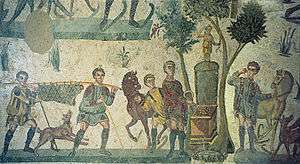
Ancient Roman cuisine changed over the long duration of the ancient Roman civilization. Dietary habits were affected by the influence of Greek culture, the political changes from kingdom to republic to empire, and the empire's enormous expansion, which exposed Romans to many new provincial culinary habits and cooking methods.
In the beginning, dietary differences between Roman social classes were not very great, but disparities developed with the empire's growth.
Meals
Traditionally, a breakfast called ientaculum[1] was served at dawn. In the late morning, Romans ate a small lunch, and in the evening they ate cena,[1] the main meal of the day. With the increased importation of foreign foods, the cena grew larger in size and included a wider range of foods. It gradually shifted to the afternoon, while the vesperna,[2] a light supper eaten in the evening was abandoned completely. Prandium, a second breakfast, was introduced around noon. Among the lower classes of society, these changes were less pronounced as the traditional routines corresponded closely to the daily rhythms of manual labor.

Among the upper classes, who did not engage in manual labor, it became customary to schedule all business obligations in the morning. After the prandium, the last responsibilities would be discharged, and a visit would be made to the baths. Around 2 p.m.,[3] the cena would begin. This meal could last until late in the night, especially if guests were invited, and would often be followed by comissatio, a round of alcoholic beverages.
In the period of the kings and the early Republic, but also in later periods (for the working classes), the cena essentially consisted of a kind of porridge, the puls.[4] The simplest kind would be made from emmer, water, salt and fat. The more sophisticated kind was made with olive oil, with an accompaniment of assorted vegetables when available. The richer classes ate their puls with eggs, cheese, and honey and it was also occasionally served with meat or fish.
Over the course of the Republican period, the cena developed into 2 courses: a main course and a dessert with fruit and seafood (e.g. molluscs, shrimp). By the end of the Republic, it was usual for the meal to be served in 3 parts: one course (gustatio), main course (primae mensae), and dessert (secundae mensae).
Foods and ingredients
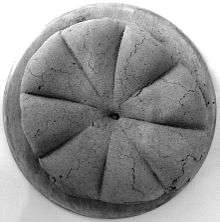
Originally flat, round loaves made of emmer (a cereal grain closely related to wheat) with a bit of salt were eaten; among the upper classes, eggs, cheese, and honey, along with milk and fruit were also consumed. In the Imperial period, around the beginning of the Christian era, bread made of wheat was introduced; with time, more and more wheaten foods began to replace emmer loaves. The bread was sometimes dipped in wine and eaten with olives, cheese, and grapes. At the time of the destruction of Pompeii in AD 79, there were at least 33 bakeries in that city.[5]
The ancient Roman diet included many items that are staples of modern Italian cooking. Pliny the Elder discussed more than 30 varieties of olive, 40 kinds of pear, figs (native and imported from Africa and the eastern provinces), and a wide variety of vegetable.[lower-alpha 1][7] Some of these vegetables are no longer present in the modern world, while others have undergone significant changes. Carrots of different colors were consumed, but not in orange.[8] However, some foods considered characteristic of modern Italian cuisine were not used.[9] In particular, spinach and aubergine were introduced later from the Arab world, and tomatoes and capsicum peppers only appeared in Europe following the discovery of the New World and the Columbian Exchange.[9] There were also few citrus fruits.[9]
Butcher's meat was an uncommon luxury. The most popular meat was pork, including sausages.[10] Beef was uncommon in ancient Rome, being more common in ancient Greece - it is not mentioned by Juvenal or Horace.[10] Seafood, game, and poultry, including ducks and geese, were more usual. For instance, on his triumph, Caesar gave a public feast to 260,000 humiliores which featured all three of these foods, but no butcher's meat.[10] John E. Stambaugh writes that meat "was scarce except at sacrifices and the dinner parties of the rich."[11]
Fish was more common than meat.[11] Aquaculture was sophisticated, with large-scale industries devoted to oyster farming.[11] The Romans also engaged in snail farming and oak grub farming.[11] Some fish were greatly esteemed and fetched high prices, such as mullet raised in the fishery at Cosa, and "elaborate means were invented to assure its freshness."[11]
Dormice were eaten, considered a delicacy.[12] A status symbol among wealthy Romans, some even had dormice weighed in front of dinner guests.[13] A sumptuary law enacted under Marcus Aemilius Scaurus forbade the eating of dormice, but failed to stop the practice.[14]
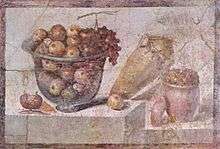
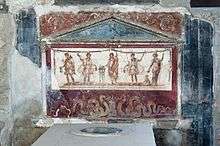
Fruit was eaten fresh when in season, and dried or preserved over winter. Popular fruits included apples, pears, figs, grapes, quinces, citron, strawberries, blackberries, currants, damson plums, dates, melons, rose hips and pomegranates.[11] Less common fruits were the more exotic azeroles and medlars. Cherries and apricots, both introduced in the first century BC, were popular. Peaches were introduced in the first century A.D. from Persia. Oranges and lemons were known but used more for medicinal purposes than in cookery. [11] Although known to the ancient Romans, lemons were not cultivated in Italy until the Principate.[11][15] At least 35 cultivars of pear were grown in Rome, along with three types of apples. Cato described pear culture methods similar to modern techniques.[16]
Many kinds of vegetables were cultivated and consumed.[17] These included celery, garlic, yellow squash, cabbage and other brassicas (such as kale and broccoli), lettuce, endive, onion, leek, asparagus, radishes, turnips, parsnips, carrots, beets, green peas, chard, chicory, green beans, cardoons, olives, and cucumber.[17] Some vegetables were illustrated in reliefs.[18] The potato, tomato and chili pepper (capsicums) from the New World were not available in ancient Roman times nor were French beans, zucchini (courgettes), and corn (maize i.e. modern source of polenta).[18]
While the precursors of Brussels sprouts, artichokes, sweet peas, rutabaga and possibly cauliflower probably existed in Roman times, the modern cultivated forms we think of were not developed until the late Middle Ages and early Renaissance times. Cabbage was eaten both raw (sometimes dipped in vinegar) and cooked.[18] Cato greatly esteemed cabbage, believing it to be good for the digestion, and also believed that if a sick person ate a great deal of cabbage and bathed in his urine, he would recover.[19]
Legumes were limited to dried peas, sweet peas, lupines, lentils and fava beans. The Romans knew several varieties of chickpea, such as venus, ram, and punic. They were either cooked down into a broth or roasted as a snack. The Roman gourmet Apicius gives several recipes for chickpeas.[20] The ancient Romans ate walnuts, almonds, hazel nuts, pine nuts, and sesame seeds, which they sometimes pulverized to thicken spiced, sweet wine sauces for roast meat and fowl. Nuts and fruit were used in pastries, tarts and puddings sweetened with honey.
The Roman colonies provided many foods to Rome; the city received ham from Belgium, oysters from Brittany, garum from Mauritania, wild game from Tunisia, silphium (laser) from Cyrenaica, flowers from Egypt, lettuce from Cappadocia, and fish from Pontus.[21]

Cheese was eaten and its manufacture was well-established by the Roman Empire period.[22] It was part of the standard rations for Roman soldiers and was popular among civilians as well. The Emperor Diocletian (284-305 CE) fixed maximum prices for cheese.[22] The manufacture of cheese and its quality and culinary uses are mentioned by a number of Roman authors: Pliny the Elder described cheese's dietary and medicinal uses in Book 28 of Historia Naturalis, and Varro in De Agricultura described the Roman cheesemaking season (spring and summer) and compared soft, new cheeses with drier, aged cheeses. The most extensive description of Roman cheesemaking comes from Columella, from his treatise on Roman agriculture, De Re Rustica.[23]
Juscellum was a broth with grated bread, eggs, sage and saffron, described in Apicius, a Roman recipe book of the late 4th or early 5th century.[24]
Garum was the distinctive fish sauce of ancient Rome.[25] It was used as a seasoning, in place of salt; as a table condiment; and as a sauce. There were four major fish sauce types: garum, liquamen, muria, and allec.[25]It was made in different qualities, from fish such as tuna, mullet, and sea bass.[25] It could be flavoured, for example mixed with wine, or diluted with water (hydrogarum), a form popular among Roman soldiers, although the emperor Elagabalus asserted that he was the first to serve it at public banquets in Rome.[25] The most costly garum was garum sociorum, made from mackerel (scomber) at the New Carthage fisheries in Spain, and widely traded.[25] Pliny wrote in his Natural History that two congii of this sauce cost 1,000 sesterces.[26]
Cooking
One of many modes of cooking in ancient Rome was the focus, a hearth that was placed in front of the lararium, the household altar which contained small sculptures of the household deity (the lares, or guardian ancestor-spirits, and the penates, who were believed to protect the floor, the larder).[28] In homes where the lararium was built into the wall, the focus was sometimes built of raised brick into four sides, constructed against a baseboard on which a fire was lit. More common was a focus that was rectangular and portable, consisting simply of a moveable hearth with stone or bronze feet.[29] After the development of separate kitchens, the focus began to be used only for religious offerings and for warmth, rather than for cooking.[29]
Portable stoves and ovens were used by the Romans, and some had water pots and grills laid onto them. At Pompeii, most houses had separate kitchens, most fairly small, but a few large; the Villa of the Mysteries covers a nine-by-twelve meter area.[30] A number of kitchens at Pompeii had no roofs, resembling courtyards more than ordinary rooms; this allowed smoke to ventilate.[30] Kitchens that did have roofs must have been extremely smokey, since there were no chimneys, only high windows or holes in the ceiling.[31]
Many Roman kitchens had an oven (furnus or fornax), and some (such as the kitchen of the Villa of the Mysteries) had two.[32] A square or dome-shaped construction of brick or stone, these ovens had a flat floor, often of granite and sometimes lava, which were filled with dry twigs and then lit.[32] On the walls of kitchens were hooks and chains for hanging cooking equipment, including various pots and pans, knives, meat forks, sieves, graters, spits, tongs, cheese-slicers, nutcrackers, jugs for measuring, and pâté moulds.[32]
Alcoholic drinks
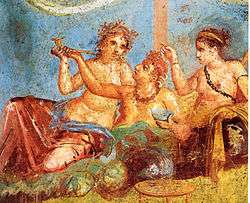
In Ancient Rome, wine was normally mixed with water immediately before drinking, since the fermentation was not controlled and the alcohol grade was high. Wine was sometimes adjusted and "improved" by its makers: instructions survive for making white wine from red and vice versa, as well as for rescuing wine that is turning to vinegar.[33] Those instructions as well as detailed descriptions of Roman viticulture date back to 160 BC in the first known text written in Latin prose.[34]
Wine was also variously flavored. For example, there was passum, a strong and sweet raisin wine, for which the earliest known recipe is of Carthaginian origin; mulsum, a freshly made mixture of wine and honey (called a pyment today); and conditum, a mixture of wine, hod matured. One specific recipe, Conditum Paradoxum, is for a mixture of wine, honey, pepper, laurel, dates, mastic, and saffron, cooked and stored for later use. Another recipe called for the addition of seawater, pitch and rosin to the wine. A Greek traveler reported that the beverage was apparently an acquired taste.[33] Sour wine mixed with water and herbs (posca) was a popular drink for the lower classes and a staple part of the Roman soldier's ration.[35]
Beer (cerevisia) was known but considered vulgar, and was associated with barbarians.[36][37]
See also
- Ancient Greek cuisine
- Byzantine cuisine, Eastern Roman Empire
- Italian cuisine
- List of ancient dishes
- Spice use in Antiquity
Notes
References
- 1 2 Artman, John:"Ancient Rome- Independent Learning Unit", page 26, Good Apple, 1991.
- ↑ Artman, John::"Ancient Rome- Independent Learning Unit", page 26, Good Apple,1991.
- ↑ Guy, John:"Roman Life", page 8, Ticktock Publishing LTD,1998.
- ↑ Greg Woolf (2007). Ancient civilizations: the illustrated guide to belief, mythology, and art. Barnes & Noble. p. 388. ISBN 978-1-4351-0121-0.
- ↑ Berry, Joanne (17 February 2011). "Bakery". Pompeii Art and Architecture Gallery. BBC. Retrieved 23 September 2016.
- ↑ André, Jacques. L'alimentation et la cuisine à Rome. Paris: Les Belles Lettres, 1981.
- ↑ Phyllis Pray Bober, Art, Culture, and Cuisine: Ancient and Medieval Gastronomy, University of Chicago Press (2001), p. 187-88.
- ↑ Phyllis Pray Bober, Art, Culture, and Cuisine: Ancient and Medieval Gastronomy, University of Chicago Press (2001), p. 188.
- 1 2 3 Phyllis Pray Bober, Art, Culture, and Cuisine: Ancient and Medieval Gastronomy, University of Chicago Press (2001), p. 187.
- 1 2 3 Maguelonne Toussaint-Samat, A History of Food, John Wiley & Sons (2009), p. 93.
- 1 2 3 4 5 6 7 8 John E. Stambaugh, The Ancient Roman City, JHU Press (1988), p. 148.
- ↑ John E. Stambaugh, The Ancient Roman City, JHU Press (1988), p. 148; George A. Feldhamer, Mammalogy: Adaptation, Diversity, Ecology, JHU Press (2007), p. 359.
- ↑ Maurice Burton & Robert Burton, International Wildlife Encyclopedia (2002), p. 701.
- ↑ Patrick Faas, Around the Roman Table: Food and Feasting in Ancient Rome, University of Chicago Press (2005), p. 289-90.
- ↑ Wilhelmina F. Jashernski, Frederick G. Meyer, & Massumino Ricciardi, Plants: Evidence from Wall Paintings, Mosaics, Sculpture, Plant Remains, Graffiti, Inscriptions, and Ancient Authors, in The Natural History of Pompeii (Wilhelmina Feemster Jashemski & Frederick G. Meyer, eds.), Cambridge University Press, (2002), p. 102.
- ↑ J.F. Hancock & G.A. Lobos, Pears, in The Future of Drylands: International Scientific Conference on Desertification and Drylands Research, Tunis, Tunisia (2006), Springer (2008) p. 304.
- 1 2 Patrick Faas, Around the Roman Table: Food and Feasting in Ancient Rome, University of Chicago Press (2005), p. 209.
- 1 2 3 Patrick Faas, Around the Roman Table: Food and Feasting in Ancient Rome, University of Chicago Press (2005), p. 232.
- ↑ Patrick Faas, Around the Roman Table: Food and Feasting in Ancient Rome, University of Chicago Press (2005), p. 233.
- ↑ Wikipedia entry for chickpea
- ↑ Patrick Faas, Around the Roman Table: Food and Feasting in Ancient Rome, University of Chicago Press (2005), p. 27.
- 1 2 P.F. Fox and P.L.H. McSweeney, Cheese: An Overview, in Cheese: Chemistry, Physics, and Microbiology Vol. 1 (3d ed.), p. 2-3.
- ↑ P.F. Fox and P.L.H. McSweeney, Cheese: An Overview, in Cheese: Chemistry, Physics, and Microbiology Vol. 1 (3d ed.), p. 2-3
- ↑ Way, A. (1843). Promptorium parvulorum sive clericorum, lexicon Anglo-Latinum princeps, recens. A. Way. Camden Society. p. 268. Retrieved May 18, 2016.
- 1 2 3 4 5 Harlan Walker, Fish: Food from the Waters, Proceedings of the Oxford Symposium on Food and Cookery, 105-06 (1998).
- ↑ Harlan Walker, Fish: Food from the Waters, Proceedings of the Oxford Symposium on Food and Cookery, 106 (1998).
- ↑ J. Carson Webster, The Labors of the Months in Antique and Mediaeval Art to the End of the Twelfth Century, Studies in the Humanities 4 (Northwestern University Press, 1938), p. 128. In the collections of the Hermitage Museum.
- ↑ Faas, p. 50-52.
- 1 2 Faas, p. 52.
- 1 2 Faas, p. 130.
- ↑ Faas, p. 140.
- 1 2 3 Faas, p. 132.
- 1 2 Erdoes, Richard (1981), 1000 Remarkable Facts about Booze, New York: The Rutledge Press, p. 88, ISBN 0831709588
- ↑ Stilo, Aelius. "Wine and Rome". University of Chicago. Retrieved 11 December 2014.
- ↑ Dalby, Andrew (2003). Posca. Food in the Ancient World from A to Z. Routledge. p. 270. ISBN 0-415-23259-7.
- ↑ Stambaugh, John E. (1988), The Ancient Roman City, Baltimore: Johns Hopkins University Press, p. 149, ISBN 0801835747
- ↑ Bonfante, Larissa (2011), The Barbarians of Ancient Europe: Realities and Interactions, New York: Cambridge University Press, p. 23, ISBN 9780521194044
Further reading
- Gold, Barbara K.; Donahue, John F. (2005). Roman Dining: A Special Issue of American Journal of Philology. JHU Press. ISBN 978-0-8018-8202-9.
- Faas, Patrick; Whiteside, Shaun (2005). Around the Roman Table: Food and Feasting in Ancient Rome. University of Chicago Press. ISBN 978-0-226-23347-5.
- Dalby, Andrew (2003). Food in the ancient world from A to Z. London, New York: Routledge. ISBN 0-415-23259-7.
- Dalby, Andrew (2000). Empire of Pleasures. London, New York: Routledge. ISBN 0-415-18624-2.
- Grocock, Christopher; Grainger, Sally (2006). Apicius. A critical edition with an introduction and an English translation. Totnes: Prospect Books. ISBN 1-903018-13-7. [includes Vinidarius]
- Ricotti, Eugenia Salza Prina (1995). Dining as a Roman emperor: how to cook ancient Roman recipes today. Rome: L'Erma di Bretschneider.
External links
| Wikimedia Commons has media related to Ancient Roman food. |
- Pass the Garum: Recreations of Roman recipes
- Eight recipes for an ancient Roman dinner
- resourcesforhistory.com: Food in Roman Britain